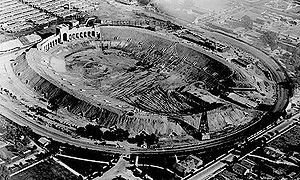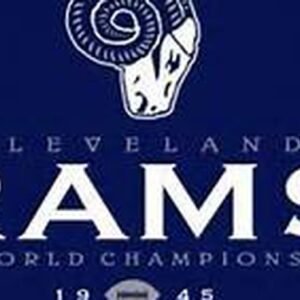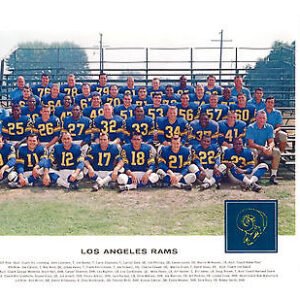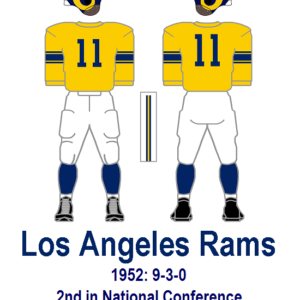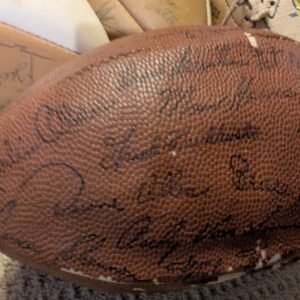Description
The 1946 Los Angeles Rams season marked the beginning of a new era for the franchise as they relocated from Cleveland to Los Angeles after World War II. This was a significant turning point for the Rams and the NFL, as the league was expanding and evolving, and the Rams became the first NFL team based on the West Coast.
Here’s a breakdown of the 1946 Los Angeles Rams:
Key Points about the 1946 Los Angeles Rams:
-
Record:
- The 1946 Los Angeles Rams finished the regular season with a 6-4 record. While not dominant, the team was competitive and made a strong return to form after a few challenging years during and immediately after World War II.
- The team finished in second place in the NFL’s Western Division, just behind the Chicago Bears.
-
Coaching:
- Robert “Pete” Cawthon remained the head coach for the 1946 season. Despite some struggles earlier in the franchise’s history, he was at the helm for the team’s transition to Los Angeles.
- Cawthon’s tenure was largely defined by the team’s lack of consistent success, and after the 1946 season, he would leave the Rams.
-
Key Players:
- Bob Waterfield, one of the most prominent quarterbacks in NFL history, played a significant role in leading the team. He was an excellent passer and one of the key offensive weapons for the Rams.
- Ace Parker, another key player, continued to contribute significantly at halfback.
- Tom Fears, a future Hall of Fame wide receiver, began his career with the Rams in 1946, adding a major offensive weapon for the team.
-
Move to Los Angeles:
- The Rams’ move to Los Angeles was monumental for the NFL. Los Angeles was an emerging media hub and the West Coast was largely untapped for professional football at the time. This marked the first time an NFL team had played in California, which set the stage for the NFL’s expansion in that region.
- The team played its home games at Memorial Coliseum, which became a central venue for the Rams.
-
Cultural Impact:
- The move to Los Angeles had a major cultural impact, as the Rams brought the NFL to a new, growing market with a large, diverse population. This shift helped broaden the NFL’s reach and eventually played a role in the development of professional football on the West Coast.
- The team also started to gain attention from Hollywood and media outlets in Los Angeles, helping build the Rams’ brand in a new era.
-
NFL’s Post-War Growth:
- The 1946 season was a pivotal year for the NFL, as the league was recovering from the war years and was in the midst of significant growth. The Rams’ relocation, alongside the return of many NFL stars from the war, helped to revitalize the league.
- In 1946, the NFL also expanded with the addition of more teams, including the Cleveland Browns, San Francisco 49ers, and Baltimore Colts.
Legacy:
- The 1946 Los Angeles Rams were significant for starting the team’s West Coast era. They were part of the first wave of NFL teams to move to California, a move that would greatly shape the future of professional football.
- Despite their modest success in 1946, the Rams laid the foundation for future successes, and the 1940s marked the beginning of a more competitive and nationally recognized team in Los Angeles.
- The Los Angeles Rams would go on to become one of the most storied franchises in NFL history, with multiple Super Bowl appearances and a long-standing rivalry with teams like the San Francisco 49ers.
Conclusion:
The 1946 Los Angeles Rams marked the beginning of a new chapter in both the team’s and the NFL’s history. Despite finishing with a decent record, the team’s relocation to Los Angeles helped establish the NFL on the West Coast and set the stage for the franchise’s future success. This was a transitional year that helped the Rams rebuild after their earlier years in Cleveland and move toward becoming one of the most recognizable teams in the league.
Head Coach: Adam Walsh
- To be listed, a player must have played at least one game for the team during this season.
- * Hall of Fame
- + Primary starter
| Pos | # | Player | GP | GS | Start Pos | Exp | DOB | Ht | Wt | College | |
|---|---|---|---|---|---|---|---|---|---|---|---|
| HB/DB | Jack Banta | 10 | 4 | 11/19/1917 | ‘ “ | Southern California | |||||
| E/DE | Jim Benton | 11 | 8 | 09/25/1916 | ‘ “ | Arkansas | |||||
| DT/T | Gil Bouley | 11 | 2 | 11/15/1921 | ‘ “ | Boston College | |||||
| C/LB | Bob deLauer | 11 | 2 | 08/30/1920 | ‘ “ | Southern California | |||||
| G | Roger Eason | 9 | 2 | 07/31/1918 | ‘ “ | Oklahoma | |||||
| HB/DB | Tom Farmer | 8 | 1 | 04/17/1921 | ‘ “ | Iowa | |||||
| T | Jake Fawcett | 4 | 4 | 05/29/1919 | ‘ “ | Southern Methodist | |||||
| HB/DB/TB | Fred Gehrke | 10 | 3 | 04/24/1918 | ‘ “ | Utah | |||||
| E/DE | Ray Hamilton | 11 | 5 | 01/21/1916 | ‘ “ | Arkansas | |||||
| C/LB | Roger Harding | 10 | 2 | 06/11/1923 | ‘ “ | California | |||||
| QB/DB | Jim Hardy | 9 | 1 | 04/24/1923 | ‘ “ | Southern California | |||||
| HB/DB | Tommy Harmon | 10 | 1 | 09/28/1919 | ‘ “ | Michigan | |||||
| E/DE | Red Hickey | 8 | 3 | 02/14/1917 | ‘ “ | Arkansas | |||||
| LB/FB/BB | Bob Hoffman | 10 | 3 | 12/13/1917 | ‘ “ | Southern California | |||||
| FB/LB | Mike Holovak | 11 | 1 | 09/19/1919 | ‘ “ | Boston College | |||||
| T | Clyde Johnson | 11 | 1 | 08/22/1917 | ‘ “ | Kentucky | |||||
| G/LB | Mike Lazetich | 10 | 2 | 08/27/1921 | ‘ “ | Michigan | |||||
| G | Les Lear | 11 | 3 | 08/22/1918 | ‘ “ | Manitoba (Canada) | |||||
| G/T | Len Levy | 10 | 2 | 02/19/1921 | ‘ “ | Minnesota | |||||
| G/LB | Riley Matheson | 11 | 8 | 12/06/1914 | ‘ “ | Texas – El Paso | |||||
| G/LB | Art Mergenthal | 9 | 2 | 03/21/1921 | ‘ “ | Notre Dame | |||||
| C/LB | Fred Naumetz | 11 | 1 | 03/28/1922 | ‘ “ | Boston College | |||||
| T | Joe Pasqua | 4 | 3 | 07/31/1917 | ‘ “ | Southern Methodist | |||||
| E/DE | Steve Pritko | 11 | 4 | 12/21/1920 | ‘ “ | Villanova | |||||
| TB/DB/QB | Albie Reisz | 2 | 3 | 11/29/1917 | ‘ “ | Southwestern Louisiana | |||||
| LB/FB | Ralph Ruthstrom | 6 | 2 | 07/12/1921 | ‘ “ | Southern Methodist | |||||
| T/G | Elbe Schultz | 11 | 7 | 12/23/1917 | ‘ “ | Oregon State | |||||
| E/DE | Bob Shaw | 10 | 2 | 05/22/1921 | ‘ “ | Ohio State | |||||
| E/DE | Woody Strode | 10 | 1 | 07/25/1914 | ‘ “ | UCLA | |||||
| FB/LB | Steve Sucic | 4 | 1 | 04/21/1921 | ‘ “ | Illinois | |||||
| HB/DB | Kenny Washington | 6 | 1 | 08/31/1918 | ‘ “ | UCLA | |||||
| QB/DB | * | Bob Waterfield | 11 | 2 | 07/26/1920 | ‘ “ | UCLA | ||||
| FB/LB | Pat West | 10 | 2 | 02/21/1923 | ‘ “ | Southern California | |||||
| HB | Jack Wilson | 9 | 1 | 11/20/1917 | ‘ “ | Baylor |

